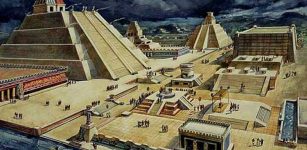Huge, Ancient Underground City Filled With Artifacts Discovered In Mardin, Turkey
Conny Waters - AncientPages.com - Turkey is home to many sophisticated, ancient underground cities, but the exact number remains an open question as several of these subterranean realms have not yet been located.
As just one of many examples, one can mention the Nevsehir Province, Central Anatolia famous for its labyrinth of tunnels, the largest and most complex underground city in the world. The vast labyrinthine network is according to experts likely to be the largest and most complex underground city in the world.
A view from the interior of the ancient underground city in Mardin. Credit: Daily Sabah
The recent discovery of many artifacts in an ancient underground city in southeastern Mardin province’s Midyat district sheds new light on the history of the region.
Mardin is one of the few cities in the world wherein the entire city has been declared a UNESCO World Heritage Site. This is because just about every inch of the city oozes history and culture, and these lands along the Tigris River have been the crossroads of civilizations since the dawn of civilization itself.
The city’s history goes back at least until the 14th century BC when it was an important spot in the Middle Assyrian Empire and known as Izala, its Persian name.
It has been more or less continuously a cultural hub of the region, and there are traces in the city from Chaldean, Nesturi, Yezidi, Jewish, Kurdish, Muslim, Syriac, Yakubi, Arab, Chechen, Armenian influences, as well as many more obscure religions and ethnicities.
Experts examine the ancient ruins. Credit: Daily Sabah
Mardin’s ancient underground city which is called Matiate is remarkable and features places of worship, silos, water wells, and passages with corridors.
While examining the subterranean city archaeologists unearthed many artifacts belonging to the second and third centuries A.D.
“In the district, a cave was found within the scope of a project started two years ago for cleaning and conservation of the historical streets and houses. After it was determined that the cave is a passage to different places with corridors, excavation works were launched to unearth the underground city,” the Daily Sabah reports.
Gani Tarkan, director of Mardin Museum and head of excavations at Matiate, said that their work will spread to the whole district. Stating that similar examples of underground cities have been found in Anatolia but that Midyat’s underground city has very different characteristics, Tarkan continued: "Matiate has been used uninterruptedly for 1,900 years.
A cave opening leading to the underground city. Credit: Daily Sabah
It was first built as a hiding place or escape area. As it is known, Christianity was not an official religion in the second century. Families and groups who accepted Christianity generally took shelter in underground cities to escape the persecution of Rome or formed an underground city. Possibly, the underground city of Midyat was one of the living spaces built for this purpose. It is an area where we estimate that at least 60-70,000 people lived underground."
A view of one of the mosaics found at the church, in Mardin, southeastern Turkey. Image credit: AA
It is expected that the number of visitors to the district will significantly increase with the complete unearthing of the underground city.
See also: More Archaeology News
Over the years archaeologists have unearthed many remarkable ancient findings in the city of Mardin. Not long ago, scientists discovered ancient mosaics belonging to a 1,600-year-old church in the village of Göktas in the southeastern Mardin province.
Based on archaeological findings so far it’s clear there is still much to discover in this region.
Written by Conny Waters - AncientPages.com Staff Writer
























